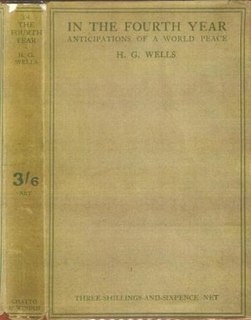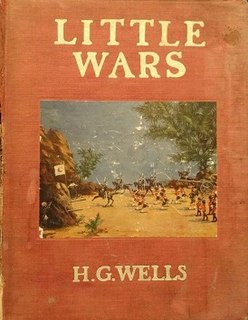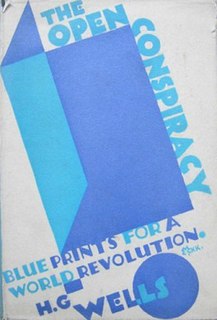 W
WBoon is a 1915 work of literary satire by H. G. Wells. It purports, however, to be by the fictional character Reginald Bliss, and for some time after publication Wells denied authorship. Boon is best known for its part in Wells's debate on the nature of literature with Henry James, who is caricatured in the book. But in Boon Wells also mocks himself, calling into question and ridiculing a notion he held dear—that of humanity's collective consciousness.
 W
WCertain Personal Matters is an 1897 collection of essays selected by H. G. Wells from among the many short essays and ephemeral pieces he had written since 1893. The book consists of thirty-nine pieces ranging from about eight hundred to two thousand words in length. A one-shilling reprint was issued in 1901 by T. Fisher Unwin.
 W
WCrux Ansata, subtitled 'An Indictment of the Roman Catholic Church' by H. G. Wells is a wartime book first published in 1943 by Penguin Books, Harmondsworth : Penguin Special No. 129. The U. S. edition was copyrighted and published in 1944 by Agora Publishing Company, New York, with a portrait frontispiece and an appendix of an interview with Wells recorded by John Rowland. The U.S. edition of 144 pages went into a third printing in August 1946.
 W
WAn Englishman Looks at the World is a 1914 essay collection by H. G. Wells containing journalistic pieces written between 1909 and 1914. The book consists of twenty-six pieces ranging from five to sixty-two pages in length. An American edition was published the same year by Harper and Brothers under the title Social Forces in England and America.
 W
WExperiment in Autobiography is an autobiographical work by H.G. Wells, originally published in two volumes. He began to write it in 1932, and completed it in the summer of 1934.
 W
WFirst and Last Things is a 1908 work of philosophy by H. G. Wells setting forth his beliefs in four "books" entitled "Metaphysics," "Of Belief," "Of General Conduct," and "Some Personal Things." Parts of the book were published in the Independent Magazine in July and August 1908. Wells revised the book extensively in 1917, in response to his religious conversion, but later published a further revision in 1929 that restored much of the book to its earlier form. Its main intellectual influences are Darwinism and certain German thinkers Wells had read, such as August Weismann. The pragmatism of William James, who had become a friend of Wells, was also an influence.
 W
WFloor Games is a book published in 1911 by H. G. Wells. This light-hearted volume argues in a humorously dictatorial tone that "The jolliest indoor games for boys and girls demand a floor." Illustrated with photographs and drawings, it briefly describes a number of games that can be played on "well lit and airy" floors with "four main groups" of toys: soldiers about two inches high, largish wooden bricks, boards and planks, and electric railway rolling stock and rails. Various remarks show that the book is based on Wells's experience of playing such games with his two sons, George Philip "Gip" Wells (1901-1985) and Frank Richard Wells (1903-1982), identified here only by their initials at their family home, 17 Church Row, in the north west London district of Hampstead.
 W
WH. G. Wells was a prolific writer of both fiction and non-fiction. His writing career spanned more than sixty years, and his early science fiction novels earned him the title of "The Father of Science Fiction".
 W
WIn the Fourth Year is a collection H.G. Wells assembled in the spring of 1918 from essays he had recently published discussing the problem of establishing lasting peace when World War I ended. It is mostly devoted to plans for the League of Nations and the discussion of post-war politics.
 W
WLittle Wars is a set of rules for playing with toy soldiers, written by English novelist H. G. Wells in 1913. The book, which had a full title of Little Wars: a game for boys from twelve years of age to one hundred and fifty and for that more intelligent sort of girl who likes boys' games and books, provided simple rules for miniature wargaming. Although first printed in 1913, an updated version was released in 2004.
 W
WA Modern Utopia is a 1905 novel by H. G. Wells.
 W
WMr. Belloc Objects to "The Outline of History" is a 1926 short book written by the British novelist H. G. Wells as a rebuttal of the criticism of historian Hilaire Belloc. In 1926, Belloc published his A Companion to Mr. Wells's "Outline of History" as a critique of Wells’ earlier historical textbook, The Outline of History. A devout Roman Catholic, Belloc was deeply offended by Wells’ treatment of Christianity in The Outline.
 W
WThe New America: The New World is a collection of four articles by H. G. Wells written to examine the American scene, which Wells summed up in 1935 as "the spectacle of a great material civilization, halted, paralyzed." Wells's articles were published shortly after a 23-day visit to the United States in March 1935 that included a lunch with US President Franklin Delano Roosevelt and a talk with Senator Huey Long.
 W
WThe New World Order is a non-fiction book written by H.G. Wells and was published by Secker & Warburg in January 1940. In The New World Order, Wells proposed a framework of international functionalism that could guide the world towards achieving world peace. To achieve these ends, Wells asserted that a socialist and scientifically planned world government would need to be formed to defend human rights.
 W
WNew Worlds for Old (1908), which appeared in some later editions with the subtitle "A Plain Account of Modern Socialism," was one of several books and pamphlets that H. G. Wells wrote about the socialist future in the period 1901-1908, while he was engaged in an effort to reform the Fabian Society.
 W
WThe Open Conspiracy: Blue Prints for a World Revolution was published in 1928 by H. G. Wells, when he was 62 years old. It was revised and expanded in 1930 with the additional subtitle A Second Version of This Faith of a Modern Man Made More Explicit and Plain. In 1931 a further revised edition appeared titled What Are We to Do with Our Lives? A final version appeared in 1933 under its original title. Many of its ideas are anticipated in Wells's 1926 novel The World of William Clissold.
 W
WThe Outline of History, subtitled either "The Whole Story of Man" or "Being a Plain History of Life and Mankind", is a work by H. G. Wells chronicling the history of the world from the origin of the Earth to the First World War. It appeared in an illustrated version of 24 fortnightly installments beginning on 22 November 1919 and was published as a single volume in 1920. It sold more than two million copies, was translated into many languages, and had a considerable impact on the teaching of history in institutions of higher education. Wells modeled the Outline on the Encyclopédie of Denis Diderot.
 W
WRussia in the Shadows is a book by H. G. Wells published early in 1921, which includes a series of articles previously printed in The Sunday Express in connection with Wells's second visit to Russia in September and October 1920. Wells was at the height of his fame, having recently completed The Outline of History, and was paid £1000 for the articles by the Sunday Express. During his visit to Russia he visited his old friend Maxim Gorky, whom he had first met in 1906 on a trip to the United States, and who arranged Wells's meeting with Lenin.
 W
WThe Science of Life is a book written by H. G. Wells, Julian Huxley and G. P. Wells, published in three volumes by The Waverley Publishing Company Ltd in 1929–30, giving a popular account of all major aspects of biology as known in the 1920s. It has been called "the first modern textbook of biology" and "the best popular introduction to the biological sciences". Wells's most recent biographer notes that The Science of Life "is not quite as dated as one might suppose".
 W
WA Short History of the World is a period-piece non-fictional historic work by English author H. G. Wells first published by Cassell & Co, Ltd Publishing in 1922. It was first published in Penguin Books in 1936. Later editions were published with updated accounts of world events. It was republished under Penguin Classics in 2006. The book was largely inspired by Wells's earlier 1919 work The Outline of History.
 W
WThe Story of a Great Schoolmaster is a 1924 biography of Frederick William Sanderson (1857–1922) by H. G. Wells. It is the only biography Wells wrote. Sanderson was a personal friend, having met Wells in 1914 when his sons George Philip ('Gip'), born in 1901, and Frank Richard, born in 1903, became pupils at Oundle School, of which Sanderson was headmaster from 1892 to 1922. After Sanderson died while giving a lecture at University College London at which he was introduced by Wells, the famous author agreed to help produce a biography to raise money for the school. But in December 1922, after disagreements emerged with Sanderson's widow about his approach to the subject, Wells withdrew from the official biography and published his own work separately.
 W
WTravels of a Republican Radical in Search of Hot Water is a collection of essays by H.G. Wells written in 1939. It is best known for the following description:A bush fire is not an orderly invader, but a guerrilla. It advances by rushes, by little venomous tongues of fire in the grass; it spreads by sparks burning leaves and bark. Its front is miles deep. It is here, it is there, like a swarm of venomous wasps. It shams dead and stabs you in the back. It encircles you so that there is no sure line of flight for its intended victims. It destroys bridges in your rear. It bars the road with blazing trees.
 W
WWar and the Future (1917) is a work of war propaganda by H. G. Wells that was published in North America under the title Italy, France, and Britain at War. Wells would have preferred the title The War of Ideas, but his publisher over-ruled him. Except for the opening piece, its chapters were published as articles in the press. Though proclaiming early in the volume that "I avow myself an extreme Pacifist," Wells staunchly supported Britain's war against Germany "in the hope that so we and the world may be freed from the German will-to-power and all its humiliating and disgusting consequences henceforth for ever."
 W
WThe Way the World is Going is a 1928 nonfiction book written by British author H. G. Wells.
 W
WThe Work, Wealth and Happiness of Mankind by H. G. Wells is the final work of a trilogy of which the first volumes were The Outline of History (1919–1920) and The Science of Life (1929). Wells conceived of the three parts of his trilogy as, respectively, "a survey of history, of the science of life, and of existing conditions." Intended as an unprecedented "picture of all mankind to-day" in all its manifold activities, he called it "the least finished work . . . because it is the most novel." He hoped the volumes would play a role in the open conspiracy to establish a progressive world government that he had been promoting since the mid-1920s.
 W
WWorld Brain is a collection of essays and addresses by the English science fiction pioneer, social reformer, evolutionary biologist and historian H. G. Wells, dating from the period of 1936–1938. Throughout the book, Wells describes his vision of the World Brain: a new, free, synthetic, authoritative, permanent "World Encyclopaedia" that could help world citizens make the best use of universal information resources and make the best contribution to world peace.
 W
WA Year of Prophesying collects 55 newspaper columns written by H.G. Wells in 1923 and 1924.